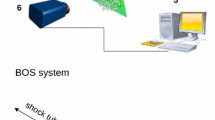Abstract
Classic examples of low-Reynolds recirculating cavity flows are typically generated from lid-driven boundary motion at a solid–fluid interface, or alternatively may result from shear flow over cavity openings. Here, we are interested in an original family of boundary-driven cavity flows occurring, in contrast to classic setups, at fluid–fluid interfaces. Particle image velocimetry (PIV) is used to investigate the structure of internal convective flows observed in thin liquid shells. Under the specific configuration investigated, the soap bubble’s liquid shell is in fact in motion and exhibits sporadic local “bursts”. These bursts induce transient flow motion within the cavity of order Re ∼ O(1). The combination of PIV and proper orthogonal decomposition (POD) is used to extract dominant flow structures present within bubble cavities. Next, we show that thermally induced Marangoni flows in the liquid shell can lead to forced, (quasi) steady-state, internal recirculating flows. The present findings illustrate a novel example of low-Reynolds boundary-driven cavity flows.
Graphical Abstract













Similar content being viewed by others
References
Bastacky JL, Goerke CYC, Houshafar J, Yager H, Kenaga D, Speed L, Chen TP, Clements JA (1995) Alveolar lining is thin and continuous: low-temperature scanning electron microscopy of rat lung. J Appl Physiol 79:1615–1628
Bernero S, Fiedler HE (2000) Application of particle image velocimetry and proper orthogonal decomposition to the study of a jet in a counter flow. Exp Fluids 29:S274–S281
Cazabat AM, Heslot F, Troian SM, Carles P (1990) Fingering instability of thin spreading films driven by temperature gradients. Nature 346:824–826
Chattopadhyay A (1999) Molecules in a thin bubble membrane. Langmuir 15:7881–7885
Chattopadhyay A (2000) Time-dependent changes in a shampoo bubble. J Chem Educ 77:1339
Couder Y, Chomaz JM, Rabaud M (1989) On the hydrodynamics of soap films. Physica D 37:384–405
Eisenberg C (1992) The science of soap films. Dover Publication, NY
Haber S, Butler JP, Brenner H, Emanuel I, Tsuda A (2000) Shear flow over self-similar expanding pulmonary alveolus during rhythmical breathing. J Fluid Mech 405:243–268
Harris JW, Stoker H (1998) Handbook of mathematics and computational science. Springer, New York
Higdon JJL (1985) Stokes flow in arbitrary two-dimensional domains: shear flow over ridges and cavities. J Fluid Mech 158:195–226
Kataoka DE, Troian SM (1999) Liquid flow on the microscopic scale. Nature 402:794–797
Leong CW, Ottino JM (1989) Experiments on mixing due to chaotic advection in cavity. J Fluid Mech 402:463–469
Lumley JL (1970) Stochastic tools in turbulence. Academic Press, London
Ozsoy E, Rambaud P, Sitiou A, Riethmuller ML (2005) Vortex characteristics in laminary cavity flow at very low Mach number. Exp Fluids 38:133–145
Pan F, Acrivos A (1967) Steady flow in rectangular cavities. J Fluid Mech 28:643–655
Pedersen JM, Meyer KE (2002) POD analysis of flow structures in a scale model of a ventilated room. Exp Fluids 33:940–949
Pozrikidis C (1994) Shear flow over a plane wall with an axisymmetric cavity or a circular orifice of finite thickness. Phys Fluids 6:68–79
Rashidnia N, Balasubramaniam R (1991) Thermocapillary migration of liquid droplets in a temperature gradient in a density matched system. Exp Fluids 11:167–174
Rhee HS, Koseff JR, Street RL (1984) Flow visualization of a recirculating flow by rheoscopic liquid and liquid crystal techniques. Exp Fluids 2:57–64
Roman FL, Faro J, Velasco S (2001) A simple experiment for measuring the surface tension of soap solutions. Am J Phys 69:920–921
Rösgen T (2003) Optimal subpixel interpolation in particle image velocimetry. Exp Fluids 35:252–256
Sarma TK, Chattopadhyay A (2001) Simultaneous measurement of flowing fluid layer and film thickness of a soap bubble using a UV–visible spectrophotometer. Langmuir 17:6399–6403
Scriven LE, Sternling CV (1960) The Marangoni effects. Nature 187:186–188
Shankar PN (1993) The eddy structure in Stokes flow in a cavity. J Fluid Mech 250:371–383
Shankar PN (1997) Three-dimensional eddy structure in a cylindrical container. J Fluid Mech 342:97–118
Shankar PN, Deshpande MD (2000) Fluid mechanics in the driven cavity. Annu Rev Fluid Mech 32:93–136
Shen C, Floryan JM (1985) Low Reynolds number flow over cavities. Phys Fluids 28:3191–3202
Sirovich L (1987) Turbulence and the dynamics of coherent structures. Part 1: Coherent structures. Q Appl Math 45:561–590
Sznitman J, Rösgen T (2008) Acoustic streaming flows in a cavity: an illustration of small-scale inviscid flow. Physica D 237:2240–2246
Sznitman J, Rösgen T (2008) Acoustic streaming visualization in elastic spherical cavities. J Vis 11:347–355
Taneda S (1979) Visualization of separating Stokes flow. J Phys Soc Jpn 46:1935–1942
Tobak M, Peake DJ (1982) Topology of three-dimensional separated flows. Annu Rev Fluid Mech 14:61–85
Author information
Authors and Affiliations
Corresponding author
Appendix
Appendix
For a soap bubble of height, h, blown at an opening of radius, r o, the volume, V, of the liquid shell is described by a spherical cap model such that (Harris and Stoker 1998):
where \(h = R + \sqrt{R^2-r^2_{\text{o}}}.\) For a given bubble radius, R, in the range of volumes considered (0.2–0.7 ml), the difference in volume relative to that of a sphere, where V = 4/3 πR 3, remains below 10%.
Rights and permissions
About this article
Cite this article
Sznitman, J., Rösgen, T. Visualization of low Reynolds boundary-driven cavity flows in thin liquid shells. J Vis 13, 49–60 (2010). https://doi.org/10.1007/s12650-009-0011-8
Received:
Revised:
Accepted:
Published:
Issue Date:
DOI: https://doi.org/10.1007/s12650-009-0011-8




